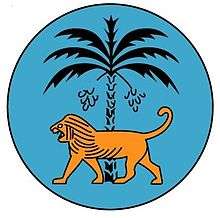Zechariah Seal


The Zechariah seal is an emblem used by a number of families of Jewish heritage. The exact origins of the seal are unclear, yet the symbolism of its elements is universally agreed upon.
Introduction


The seal consists of three distinct elements. A stylised Lion of Judah in the 'statant' position, a Judea Date Palm and the phrase "Chazak Ve'ematz" in Hebrew. The Lion of Judah reflects the families lineage from the Ancient Israelite tribe of Judah. It is strikingly similar to the lion present on the "Megiddo Seal" used by a minister in the government of King Jeroboam II.[1] The Judea Date Palm has long been a Jewish symbol, pre-dating the Star of David by many centuries. It is used in Jewish iconography and seen to be reflective of beauty, fruitfulness and the land of Israel, being one of the seven species.[2] The seven-branched palm has also been used to represent the Menorah at times. Even the Romans frequently used the Judea Date Palm on their coinage for the province.[3][4][5]
The Hebrew phrase "Chazak Ve'ematz" is an Ancient Jewish saying meaning "Be strong and courageous." The phrase has its origins in the Book of Joshua (1:9).[6]
The combination symbolizes that the bearers of the seal possess the strength and courage of lions, but only in defence of the virtue, fruitfulness and societal contribution represented by the date palm. Furthermore, this all exists within the prism of heritage and honouring the past.
Families
A number of families have been known to use the Zechariah Seal. These have included the Gomo (Gomolinski), Adelist, Wesson and Cantor families.
Versions

The seal has been stylised in a number of different ways. Most significantly, a blue background has been added. The blue represents "Tekhelet." This is a colour with great significance in Judaism.[7]

There is also a family flag.


The Melbourne-based architect and graphic designer Elchanan Brown was heavily involved in the formation of many of the modern variants.[8]
References
- ↑ "Gate 1567 at Megiddo and the Seal of Shema, Servant of Jeroboam". www.academia.edu. Retrieved 2015-10-25.
- ↑ "Ancient Jewish History: The Seven Species".
- ↑ "Ancient Jewish Coins". www.jewishvirtuallibrary.org. Jewish Virtual Library. Retrieved 2015-10-25.
- ↑ Steven Fine, "Between Rome and Jerusalem: The Date Palm as 'Jewish Symbol," in Art And Judaism In The Greco-Roman World: Toward A New Jewish Archaeology. Cambridge University Press. 2005. pp. 140–145.
- ↑ "PALM (Phœnix dactylifera)".
- ↑ "בית המדרש הוירטואלי".
- ↑ "FAQ - Ptil Tekhelet". Ptil Tekhelet. Retrieved 2015-10-25.
- ↑ "%%%%". Fresh Studio. Retrieved 2015-10-25.